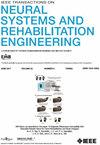基于增强肌肉骨骼模型的同步和比例控制
IF 4.8
2区 医学
Q2 ENGINEERING, BIOMEDICAL
IEEE Transactions on Neural Systems and Rehabilitation Engineering
Pub Date : 2025-02-20
DOI:10.1109/TNSRE.2025.3543912
引用次数: 0
摘要
近年来,肌肉骨骼模型(MM)被广泛研究用于从肌电信号中解码运动意图。然而,由于多块肌肉信号之间的串扰,导致多自由度协调运动时MM的解码性能下降。针对这一问题,本研究采用“分而治之”(DC)策略,结合非负矩阵分解(NMF)算法,提出了一种用于3-DoF运动预测的增强MM,命名为DC-NMF-MM。腕屈伸和MCP屈伸的控制信号来自4块独立的肌肉,腕旋前和旋后的控制信号来自8通道表面肌电信号。选取8名非残疾受试者进行线上和线下实验。在线下实验中,另外建立2个MM作为对照组,对所提出的DC-NMF-MM进行验证,包括完全采用NMF算法(T-NMF-MM)的MM和部分采用NMF算法(P-NMF-MM)仅预测手腕旋前/旋后的MM。采用Pearson相关系数和归一化均方根误差比较三种模型的预测性能。结果表明,该方法优于其他两种模型。通过建立人工神经网络和线性回归模型与所提出的模型进行比较,结果表明DC-NMF-MM模型对关节角度的预测更为准确。在在线实验中,建立了基于DC-NMF-MM的通用3-DOF肌肉骨骼模型,并以完成时间、超调次数和路径效率为评价指标。实验结果进一步证明了该方法实现三自由度运动控制的可行性。所提出的增强MM为实现临床手肌电控制提供了前提条件。本文章由计算机程序翻译,如有差异,请以英文原文为准。
Simultaneous and Proportional Control Based on an Enhanced Musculoskeletal Model
Recently, the musculoskeletal model (MM) has been widely studied for decoding movement intent from electromyography (EMG) signals. However, the decoding performance of the MM is impaired for the coordinated movements of multiple degrees of freedom (DoFs) due to the crosstalk between signals of multiple muscles. To address this problem, this study proposed an enhanced MM for 3-DoF motion prediction by taking the “divide and conquer” (DC) strategy and integrating the non-negative matrix factorization (NMF) algorithm, which is named as DC-NMF-MM. The control signals of wrist flexion/extension and MCP flexion/extension were obtained from four independent muscles, and the control signals of wrist pronation/supination were obtained from eight-channel surface EMG signals. Eight non-disabled subjects were recruited for offline and online experiment. For offline experiment, another two MMs were established and taken as the control groups for validation of the proposed DC-NMF-MM, including the MM totally taking the NMF algorithm (T-NMF-MM) and that partly taking the NMF algorithm (P-NMF-MM) for predicting the wrist pronation/supination only. The Pearson’s correlation coefficient and the normalized root mean square error were employed to compare the prediction performance of three models. The results showed that the proposed method performs better than the other two models. Moreover, artificial neural network and linear regression model were established to compare with the proposed model and the results showed that DC-NMF-MM is more accurate in predicting joint Angle. For online experiment, a general 3-DOF musculoskeletal model based on DC-NMF-MM was established and the completion time, the number of overshoots, and the path efficiency were taken as evaluation indexes. The results further demonstrated the feasibility of the proposed method to achieve 3-DoF motion control. The proposed enhanced MM provides a prerequisite for the realization of clinical hand myoelectric control.
求助全文
通过发布文献求助,成功后即可免费获取论文全文。
去求助
来源期刊
CiteScore
8.60
自引率
8.20%
发文量
479
审稿时长
6-12 weeks
期刊介绍:
Rehabilitative and neural aspects of biomedical engineering, including functional electrical stimulation, acoustic dynamics, human performance measurement and analysis, nerve stimulation, electromyography, motor control and stimulation; and hardware and software applications for rehabilitation engineering and assistive devices.

 求助内容:
求助内容: 应助结果提醒方式:
应助结果提醒方式:


